A Return to Normal Part 2
Are Canadians getting back to offices, shopping malls, and sports arenas “near me"?
Published July 6, 2021
In continuation of our ‘Return To’ Series, Caddle dives deeper into what Canadians will be returning to as lockdown restrictions are lifting.
As we uncover insights from our ‘Return To’ Question Series, Caddle discovered more about what else Canadians will (or will not) be returning to from 8,500 Canadians in May.
Where Are We Headed?
After a long and tiresome period of lockdown, Canada is slowly beginning the process of re-opening. Caddle wants to understand where the minds of Canadians have been wandering to as their favourite places begin opening back up. We discovered that vaccine requirements are the driving factor to get Canadians back to their favourite restaurants, movie theatres, and gyms from our previous blog post. Could this be the same for getting back into the office, shopping malls, and sports arenas?
Hey Google, Take Me to Work
Remote work has been a favourable experience for many as it allows more flexibility and freedom for employees. With an increase in online jobs and options to work from home, will Canadians be returning to the office? Prior to the pandemic, approximately 60% of Canadians responded that they used to go into the office for work. When we asked how often they would be returning after the pandemic, approximately 55% said they would be returning the same amount, and about 32% responded that they would be returning less. Now, as much as a pleasure working from the comfort of our own homes may be, Caddle also asked what factors would get Canadians from their home office chairs back into their corporate office chairs. The leading factors (come as no surprise) are vaccine requirement (21.9%), overall cleanliness (11.7%), and mask-wearing policies (10.8%).
From the following options, what would encourage you to return to the office for work (Please select all that apply)?

Compared to before the pandemic, do you plan to go into the office for work more or less often in the next 6 months?

Hey Google, Search Malls Near Me
Alright, let’s face it… shopping when you can walk around your favourite stores, try things on, and maybe even grab a bite to eat from the food court is WAY better than surfing through sites at home and pressing a checkout button. Or is it? Over 93% of Canadians used to go to shopping malls prior to the pandemic, a majority at a less than monthly basis (29.9%). However, while approximately 47% of Canadians will be returning the same amount, about 39% responded saying they would be visiting less!
Again, Caddle wanted to determine what exactly would push Canadians to return to shopping malls. According to our survey results, the three most important factors are mask-wearing policies, physical distancing policies, and overall cleanliness- with selection rates of 39.5%, 39.1%, and 38.3%, respectively. An interesting discovery, as vaccine requirements have consistently ranked amongst the top 3 in our other surveys! It looks like personal space might be valued more than vaccines during retail therapy.
From the following options, what would encourage you to return to shopping malls (Please select all that apply)?

Compared to before the pandemic, do you plan to go to shopping malls more or less often in the next 6 months?

Hey Google, Search Sports Arenas Near Me
To many, sports go further than solely being a source of entertainment, they bring people together to celebrate (hopefully) and have a good time! Before the pandemic, about 62% of Canadians used to go to sports arenas- a majority of them less often than a few times a year (24%). Looking into the future, over half of Canadians (55.2%) responded that they would be attending sports arenas at the same rate they used to before the pandemic, however, over 33% will be going less. Again, when asked what would encourage Canadians to return to sports arenas the top 3 responses were vaccine requirements (25.8%), physical distancing policies (11.1%), and overall cleanliness (11%).
From the following options, what would encourage you to return to sports arenas (Please select all that apply)?

Compared to before the pandemic, do you plan on going to sports arenas more or less often in the next 6 months?

So, what’s the deal?
We can see that a majority of Canadians will be reverting back to the same routine behaviour prior to the pandemic as lockdown procedures become more lenient. Consequently, those who will not be following the same patterns will be attending far less. Across all of Caddle’s surveys, at least 30% of Canadians will be visiting establishments less than they had before.
But, there is hope!
The number one factor encouraging Canadians to return to the office, shopping malls, and sports arenas is the requirement of vaccines (which was also the number one answer for restaurants, movies and gyms!). As the vaccination process is accelerating and more Canadians continue to get their shots, Canadians are hopeful that normalcy is closer than we think.
Main Takeaways
No.1 |
Overall cleanliness and vaccine requirements are the top 2 factors that encourage Canadians to return to the office, shopping malls, and sports arenas. Tied for the third most important factor are physical distancing and mask-wearing policies.
No.2 |
Vaccine requirements are the most important factor to encourage Canadians to return to the office, shopping malls, and sports arenas.
*Disclaimer: All data presented is owned by CaddleⓇ and has a Margin of Error of 1% or lower.
Want more Caddle insights? Sign up for our mailing list below!
A Return to Normal
Are Canadians getting back to searching for restaurants, movie theatres, and gyms “near me"?
Published June 24, 2021
As Canada shifts to fewer restrictions, how much have Canadians’ attitudes toward going out changed? After being in the pandemic for over a year, are consumers gravitating towards the stay-at-home life or hungry to get back to pre-pandemic times? After asking for the opinion of 8,500 Canadians this May 2021, Caddle made some interesting discoveries on what exactly Canadians will (or will not) be returning to.
So, what’s the big change?
As the provinces move out of a state of lockdown, Caddle wonders how the reopening of different industries will be impacted. Specifically, Caddle wanted to know what would encourage Canadians to return to some of their favourite spots – restaurants, movie theatres, and gyms.
Hey Google, Search Restaurants Near Me
Admit it, there’s nothing better than heading to your favourite Italian, Chinese, Indian, or ANY restaurant for that matter to indulge in some of your favourite foods! Prior to the pandemic, a majority of Canadians responded that they used to visit restaurants a few times a month (24.2%). While 41% of Canadians will be visiting restaurants about the same amount in the next 6 months, over 40% will be visiting less. With this information in mind, Caddle wanted to identify the factors that would increase restaurants’ attendance. Physical distancing, overall cleanliness, and vaccine requirements ranked amongst the highest with scores of 41.5%, 41.1%, and 36.8% respectively.
From the following options, what would encourage you to return to restaurants?

Compared to before the pandemic, do you plan on going to restaurants more or less often in the next 6 months?

Hey Google, Search Movie Theatres Near Me
Whether it was a trip to Cineplex, Landmark Cinemas, or even from the comfort of our own homes, movies provide a great source of entertainment. A majority of Canadians responded that they used to attend movie theatres multiple times a year (32.9%). However, similar to the responses from our restaurant survey, over 45% of Canadians will be visiting movie theatres less in the next 6 months. When asked what would encourage Canadians to return back to movie theaters, it is no surprise that the top 3 responses are physical distancing, vaccine requirement, and overall cleanliness- with scores of 39.9%, 34.2%, and 33.6% respectively.
From the following options, what would encourage you to return to movie theatres?

Compared to before the pandemic, do you plan on going to movie theatres more or less often in the next 6 months?

Hey Google, Search Gyms Near Me
When was the last time you laced up your gym shoes and headed to the gym? Before the pandemic, not including those who did not go to a gym, The biggest cohort of gym-goers went to the gym a few times a week (14.2%). Over half of Canadians say in the next 6 months they will be visiting the gym the same amount as before (57.3%) and approximately 29% will be attending less than before. So, what will make Canadians return? To get Canadians back into the fitness world, the top 3 reasons (that have been consistent across the board) are overall cleanliness (24.3%), vaccine requirement (23.3%), and physical distancing (21.1%).
From the following options, what would encourage you to return to the gym?

Compared to before the pandemic, do you plan on going to a gym more or less often in the next 6 months?

How Are We Going To Return To Normal?
Of all the reasons to go back to some of our favourite places, what did Canadians voice would encourage them the most? According to our survey results, a majority of Canadians responded that when returning back to restaurants, movie theatres, or gyms they would be most encouraged if vaccines were required. With the accelerated vaccine distribution, could this mean normalcy isn’t so far around the corner?
Main Takeaways
No.1 |
Physical distance, overall cleanliness, and vaccine requirements are the top 3 factors that encourage Canadians to return to restaurants, movie theatres, and gyms.
No.2 |
Vaccine requirements are the most important factor to encourage Canadians to return back to restaurants, movie theatres, and gyms.
*Disclaimer: all data presented is owned by CaddleⓇ and has a Margin of Error of 1% or lower.
Want more Caddle insights? Sign up to our mailing list below!
Canadians Excited for Products That Help Them Get a Better Night’s Sleep
How the importance of sleep is driving product innovation
Published on May 4, 2021
We’re Losing Sleep Over What?!
COVID-19 has changed the world forever. What may have been the leading stressor in many of our lives just one year ago, has expedited the rise of a more alluring leader in sleep loss – social media use.
One in three Canadians between ages 35 to 64 report not getting enough sleep in general. When we dig deeper, approximately 19 percent of respondents between ages 15-64 said they had lost sleep as a result of social media use in the previous 12 months. The association between social media and negative experiences was higher in younger respondents, with about 47 percent of 15-19 year-olds and 28 percent of 20-24 year olds reporting losing sleep from social media use.
In 2019, the global sleep economy was valued at about $432 billion USD. This industry was forecast to be worth $585 billion USD by 2024. With the increase of sleep loss among Canadians, what are brands doing to capture this growing market?
The Sleep-Aid Market
According to Canadian Grocer, and other reports, the functional beverage market is a big bet.
“In 2016, the Canadian functional beverage market had $1.4 billion in sales—a figure that’s expected to reach $1.6 billion in 2021, according to Euromonitor International. And according to Mintel’s figures, 14% of Canadians say they drink “hybrid/fusion drinks” on a typical day.”
This past year, we have seen an increase in product innovation in these categories. For example, Pepsi launched Driftwell to capture the new, growing market of sleep-aid beverages. Caddle asked our Daily Panel what they think about the sleep-aid beverage market, and here’s what we found.
When it comes to what influences consumers’ likelihood to try, free samples are not always the No. 1 factor
For sleep aid beverages, we discovered that the top 3 influencing factors for product trials are “free samples”, “doctor referral”, and “curiosity”. It’s interesting to note that 25% of consumers are willing to try a sleep aid beverage upon doctors’ orders. With “free samples” only 5 basis points higher than “doctor referral”, perhaps this indicates that consumers are on the fence on actually trying the product without a professional’s guidance.
From the following options, what would most likely influence you to try a sleep aid beverage?

Caddle also asked our Daily Survey Panel about cannabis-infused beverages, and had some surprising results.
Unlike sleep aid, cannabis drinkables’ top influencing factor is “curiosity”. This suggests that consumers who are curious about the product category are the most likely to try, regardless of price. Though this does not mean price is irrelevant, since “free samples” is the No.2 influencing factor, it’s still notable that curiosity trumps freebies in this case. We see “doctor referral” ranked as the third most influencing factor. This potentially highlights the growing demand for cannabis products in the health & wellness space.
Interested to learn how Canadians celebrate 420 this year? Read our blog post here. Caddle also put out a full report on how brands can Cultivate Success in the Canadian Cannabis Business.
From the following options, what would most likely influence you to try cannabis beverages?

Key Takeaways
No.1 |
The functional beverages market- specifically products aiding sleep- is on the rise, and will continue to grow in the coming years.
No.2 |
Consumer curiosity can be a strong driver to new product trials – keeping your hand on the pulse on what consumers are actually curious about, and willing to try can make or break a product.
No.3 |
Free trial is not always the best way to conduct new product trials. However, market research is always the best way to learn what is. Contact Caddle to get started.
*Disclaimer: all data presented is owned by CaddleⓇ and has a Margin of Error of 1% or lower.
Want more Caddle insights? Sign up to our mailing list below!
Cannabis During COVID-19
Did 420 Get Overlooked This Year?
Published on April 21, 2021
Celebrating 420
According to Wikipedia, 420, 4:20, or 4/20 (pronounced four-twenty) is cannabis culture slang for marijuana and hashish consumption, especially smoking around the time 4:20 p.m., and also refers to cannabis-oriented celebrations that take place annually on April 20. From Statistics Canada, prevalence of cannabis consumption in Canada has been steadily increasing across all consumption levels. Now, Canada’s cannabis industry is operating at an annual run rate of about CAD $3.13 billion.
Let’s dive into how Canadians view cannabis in 2021, and whether they planned to celebrate the iconic 420 holiday during a pandemic.
COVID-19 Can’t Break Tradition
Caddle found out that 22% of Canadians who consume cannabis celebrated 420 last year, and 39% plan to celebrate this year. In actuality, some have gathered in small groups to celebrate 420, others moved the festivities online, but official numbers will likely be limited since official gatherings were cancelled due to safety concerns. As this is a holiday typically celebrated outdoors, perhaps the rise in interest is not surprising. This increase in participation may be attributed to COVID-19 coping mechanisms, or simply following the trend as we’ve seen in the past decade of increasing interest in cannabis use.
Cannabis Users Are Consistent
Due to COVID-19 restrictions this year, many 420 celebrations have been cancelled due to safety concerns. For example, Vancouver’s 420 protest and cannabis celebration with over 100,000 in attendance and over 500 vendors every year has been cancelled. In honor of 420 this week, we’re sharing some recent cannabis data.
Caddle found that for the general population, most are not participants of cannabis culture: Over 70% indicate they do not use cannabis at all.
How often do you use cannabis?

However, if we look at the data at those who do use cannabis, there is a clear picture that emerges when it comes to familiarity, usage, and participation in the celebration of cannabis.
Caddle found that of the Canadians who use cannabis, 56% use cannabis at minimum on a weekly basis, if not daily.
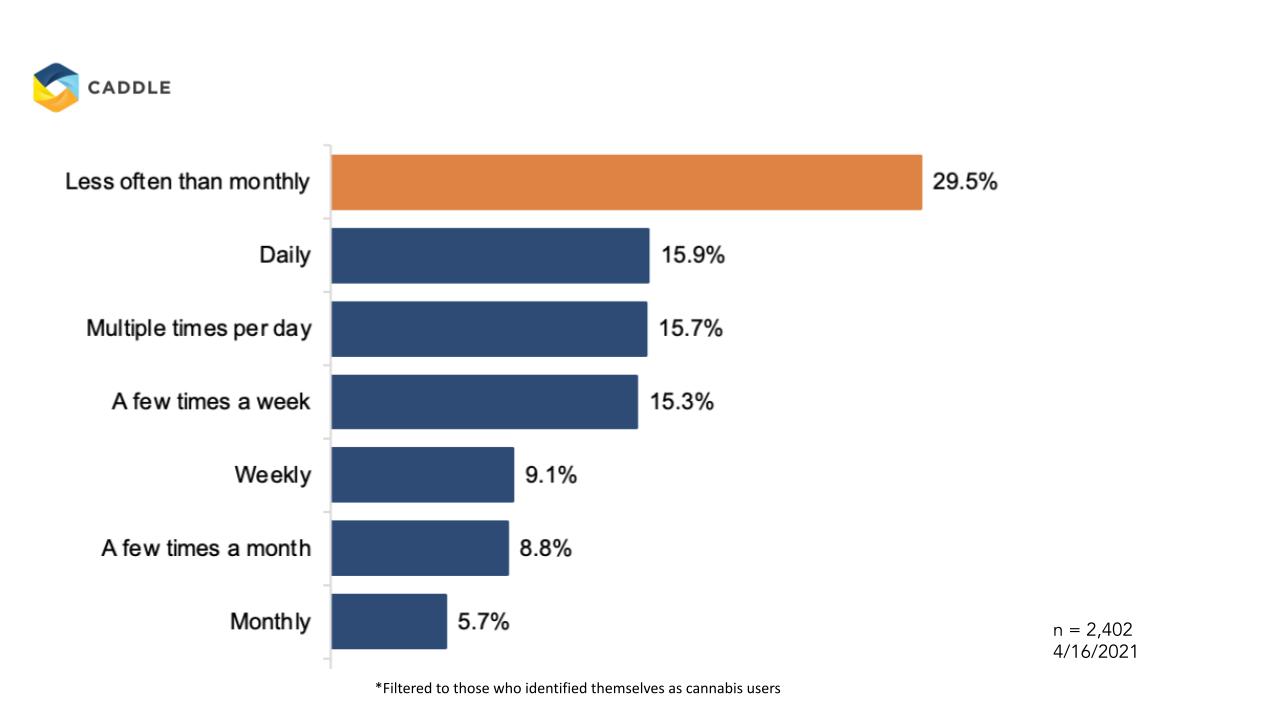
If we look further, we find that younger generations are more likely to use cannabis more frequently. When we look at gender differences, men are 11 basis points higher than women when we look at consumers who are daily to weekly users (61% vs. 52% respectively).
Why may this be the case? Younger generations are potentially more educated on cannabis and its medicinal and recreational uses. Millennials and Gen Z could also be more receptive to normalizing cannabis use, especially after its legalization in 2018. As for the gender differences, we can possibly look to the different societal pressures that may be put on men vs. women when it comes to cannabis use, and the possible stigmatization that is still present surrounding cannabis users.
Celebrating 420 Amidst COVID-19
When it comes to celebrating cannabis, around 61% of Canadians who use cannabis are familiar with 420, and their reasons for participating may surprise you.
How familiar are you with 420?
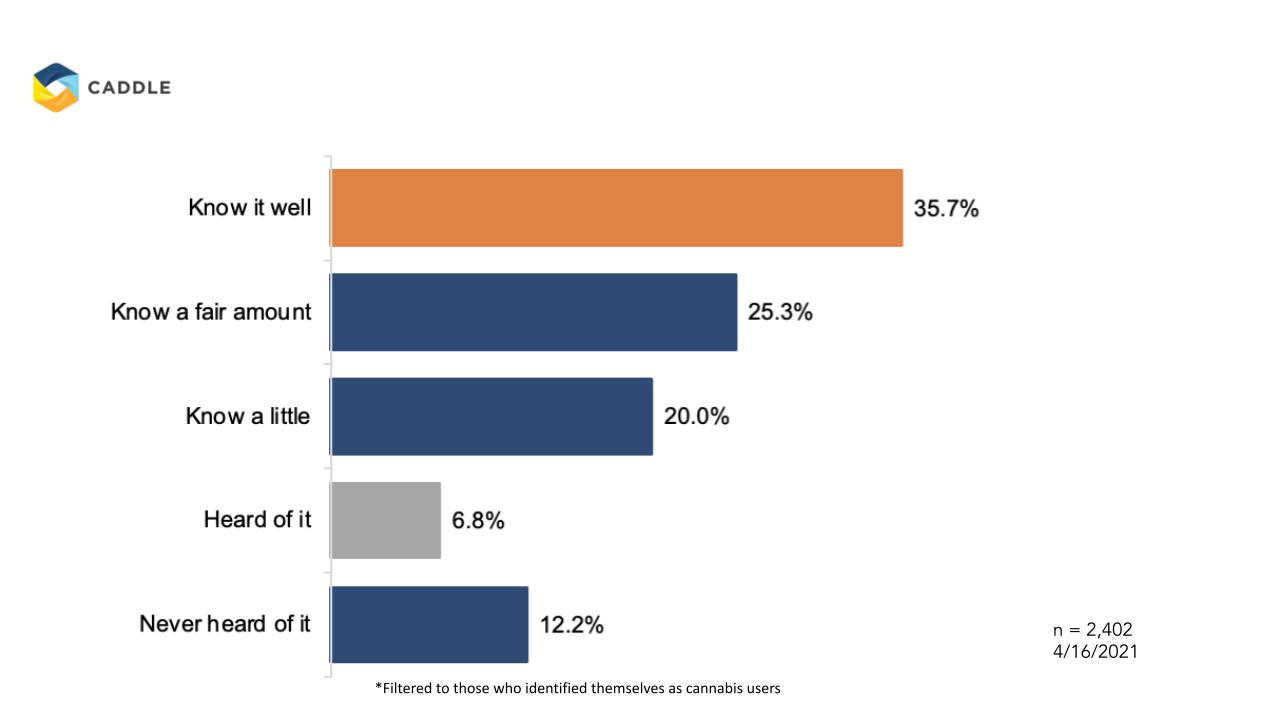
Why do you participate in 420? (select all)
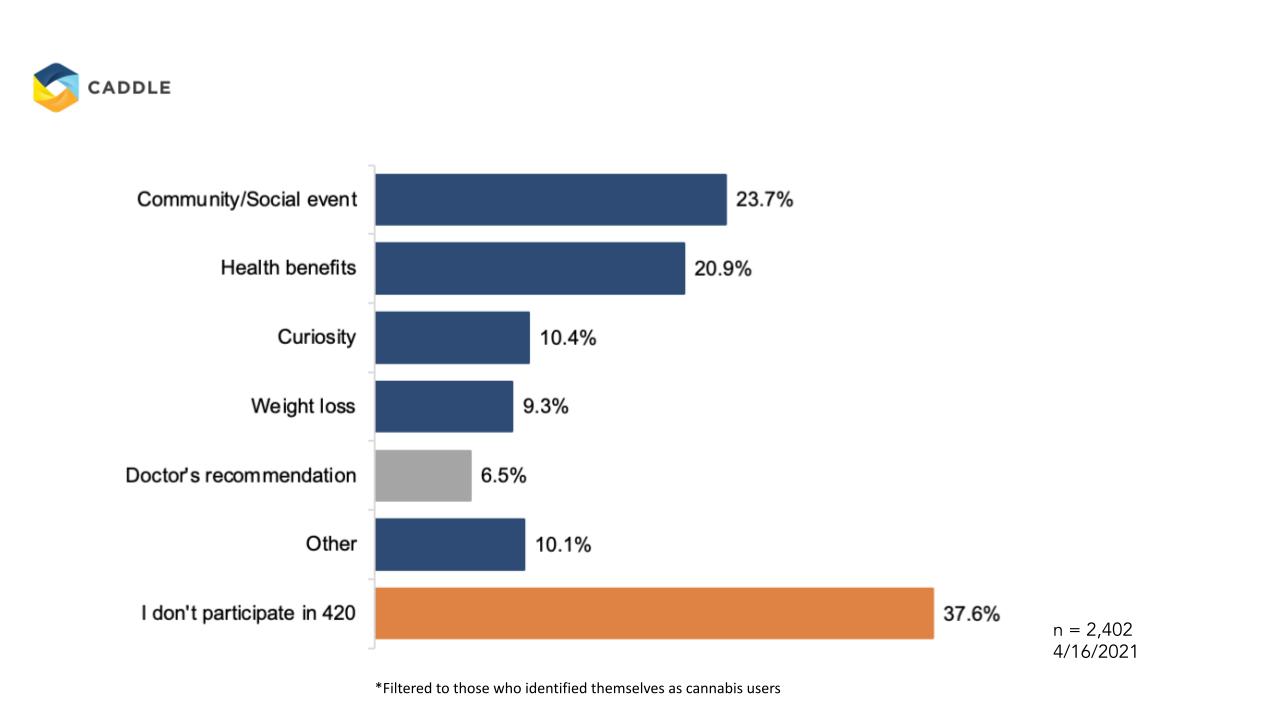
The top reason for participating in 420 is its sense of community. Next is cannabis’ associated health benefits, followed by curiosity.
Key Takeaways
No.1 |
Consumers continue to show increasing interest in cannabis products. This is especially true among Millennials and Gen Z, and men.
No.2 |
Over 60% of Canadians who use cannabis are familiar with 420, and the top 3 reasons for participating are a sense of community, health benefits, and curiosity.
No.3 |
Over half of cannabis users are using cannabis products at minimum on a weekly basis. This signals to cannabis brands that these products are becoming a habitual part of consumers’ routines, indicating strong potential to cultivate loyal customers in the cannabis market.
Want to learn more about the Canadian cannabis industry? Caddle put out a full report on how brands can Cultivate Success in the Canadian Cannabis Business. Want specific data points on the Cannabis market? Get in touch.
*Disclaimer: all data presented is owned by CaddleⓇ and has a Margin of Error of 1% or lower.
Want more Caddle insights? Sign up to our mailing list below!
Contact Us
Cultivating Success in the Canadian Cannabis Business
Exclusive Cannabis Report 2021
Published on February 1, 2021
Caddle is launching our eagerly-awaited comprehensive report on Cannabis: Cultivating Success in the Canadian Cannabis Business
What’s inside:
- How consumers perceive cannabis
- Deep insights into consumer need states
- The next big cannabis retail opportunity
- and much more!
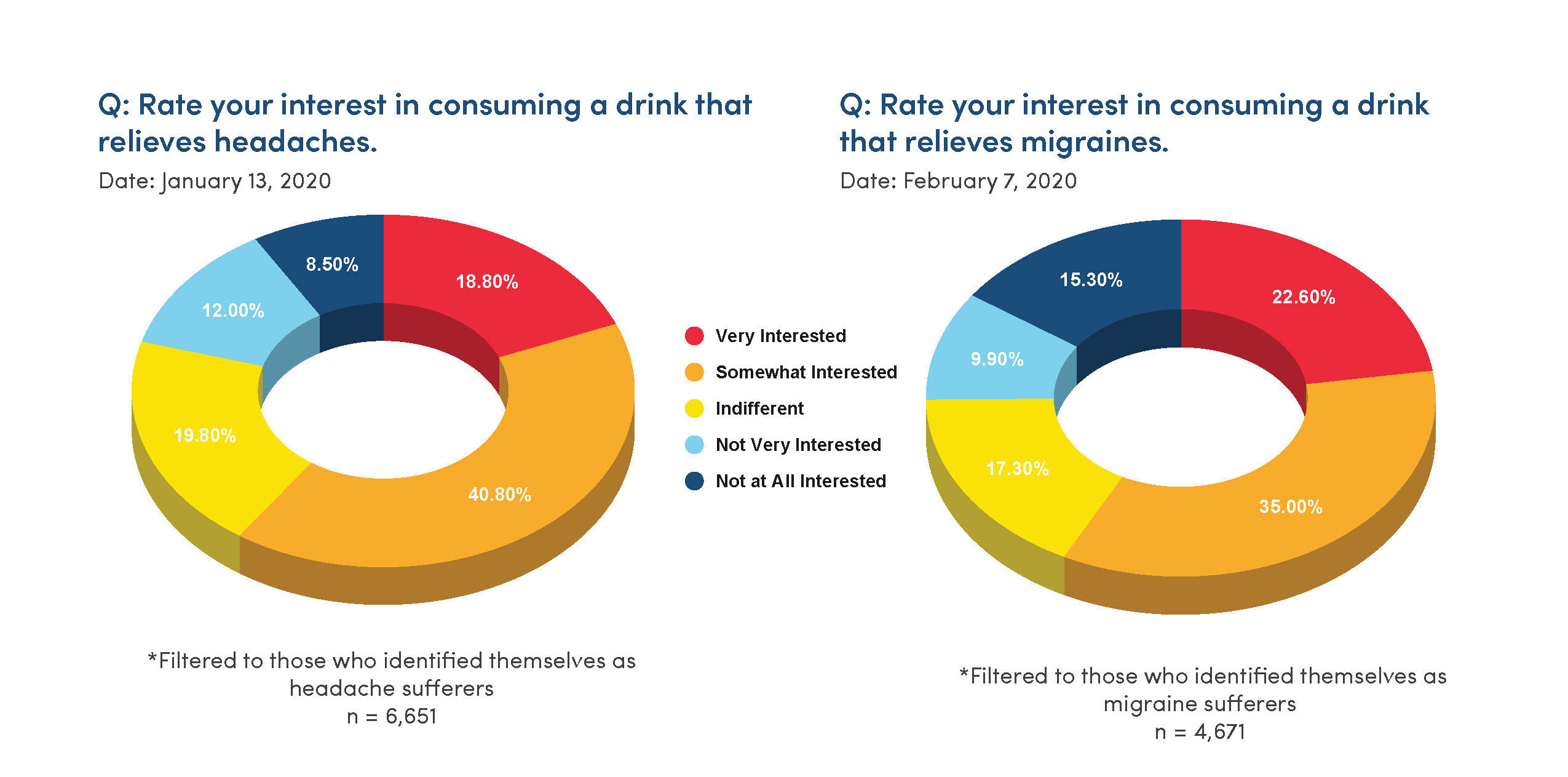

Are you looking for insights on the Canadian Cannabis market? Is your company in need of innovation? How does your Cannabis brand stand out amongst competition?
Engage with 18,000+ monthly active cannabis users (including 6,000+ daily active cannabis consumers) and get the insights you need to make decisions, faster! See details about our 18,000+ Cannabis Panel here.
*Disclaimer: all data presented is owned by CaddleⓇ and has a Margin of Error of 1% or lower.
Sign up to our email list to get more exclusive first access to Caddle Insights!
Canadians' Parenthood Plans Continue While American Parents Dwindle
COVID-19 hasn’t stopped Canadians from planning for parenthood, but it has amplified the concerns of those wanting to have a child in the next five years.
Published on December 16, 2020
You’ve likely heard stories for years now about how Canada’s population is shrinking. Yet the latest population data indicates otherwise: Canada experienced a 1.4% YOY increase in the number of people living in the country in 2019—the highest growth rate since 1989–90.
Though this increase was driven mostly by immigration, it’s still noteworthy for several reasons: First, Canada’s growth rate is the highest among G7 counties and more than 2x that of the U.S. Second, these statistics were gathered months before the COVID-19 pandemic hit global markets. With this in mind, we wondered:
- Would all of the uncertainty around the pandemic colour Canadians’ perspectives around parenthood?
- If, pre-pandemic, people were planning on having children, would they still want to after experiencing the effects of the lockdown and other restrictions?
- And, what factors come into play in Canadian consumers’ parenthood planning?
Let’s dig into the results to learn more.
HOW MANY PEOPLE HAVE KIDS AND HOW MANY PEOPLE WANT THEM?
More than 60% of our 10,000-strong Daily Survey panel are currently parents—including 80% of Baby Boomer, 74% of Gen X, 50% of Millennial and 23% Gen Z respondents.
Among these current parents, nearly 1 in 5 people had been planning, pre-pandemic, to have children within the next five years. Only a small portion of this population (~8%) had changed their parenthood plans because of the pandemic.
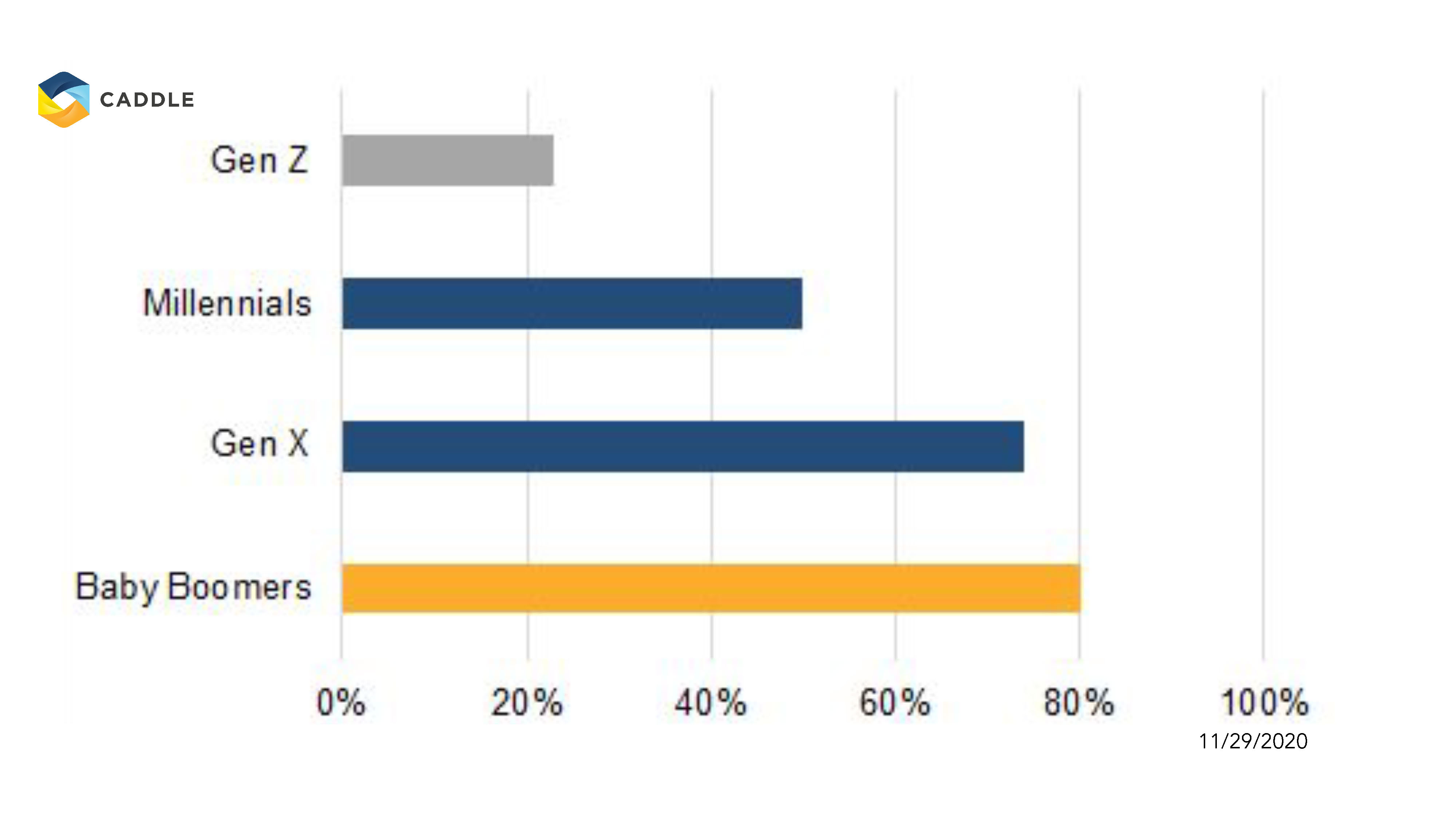
In contrast, about a quarter of non-parent respondents had been planning, pre-pandemic, to have children within the next five years and an even smaller proportion of those (6.6%) had changed their minds due to COVID-19.
Compare this to stats gleaned on our neighbours to the south: 58% of Americans who, pre-pandemic, were planning to have children in the next five years say that COVID-19 have made them less likely to want to have children.
What might be driving this trend? Well, a whopping 93% of U.S. households with school-aged children reported having to accommodate distance learning at home during the pandemic. Could this major stressor, added on top of ongoing financial and health concerns, be the reason for Americans’ burst baby bubble? Or is it just another indication of the widespread decline in global fertility rates?
(Side note: The U.S. in particular has been reporting a steady decline in fertility rates for decades, with 2019 seeing the lowest number of births in 35 years.)
WHAT’S MAKING CANADIANS PUSH OUT THEIR PARENTHOOD PLANS?
A handful of concerns are weighing heavily on Canadian consumers’ minds when it comes to having children. No surprises here, as they’re life factors we’ve seen and talked about before in relation to the pandemic.
Whether it’s due to “fear of uncertain world conditions” (36%), the “cost of living” (30.5%), “unstable employment” (28%) or more generally, stress and health concerns (both about 19% each), it’s clear that the practical effects of the pandemic are leading some Canadians to postpone child-bearing to more than five years out.
Of note:
Though the top three concerns are consistent for both parents and non-parents, current parents over-index in their “fear of uncertain world conditions” (at 37.6%), while non-parents rank the “cost of living” as their biggest consideration (at 35%). This suggests that the factor of already having children in the household could have an amplifying effect on parents’ empathy responses. In contrast, non-parents seem to be thinking more practically about their financial futures and the implications of adding another family member to the household.
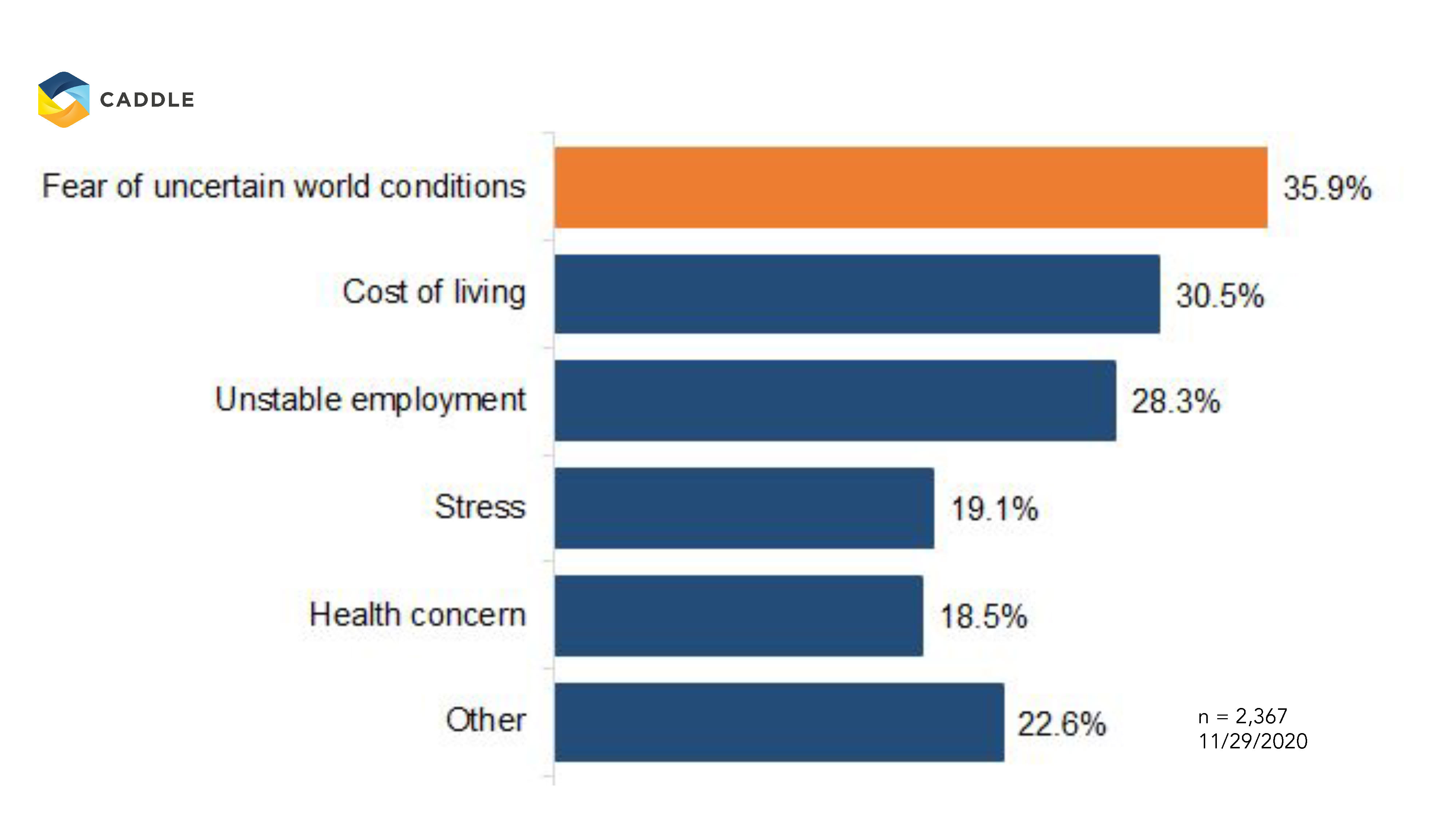
WHAT FACTORS INFLUENCE CANADIANS’ DECISION-MAKING AROUND WHETHER TO HAVE CHILDREN OR NOT?
Not surprisingly, the factors that influence respondents’ mindsets around parenthood reflect a combination of both personal and societal norms: Interestingly, only about a third of respondents identified “already having children” as the reason to have more children in the future.
Following very closely behind are respondents who “do not want children at all” (24%) and, tied for third, is the fact that they “have always wanted children” and that their spouses or themselves are “beyond child-bearing age” (16.9% and 16.5 % respectively).
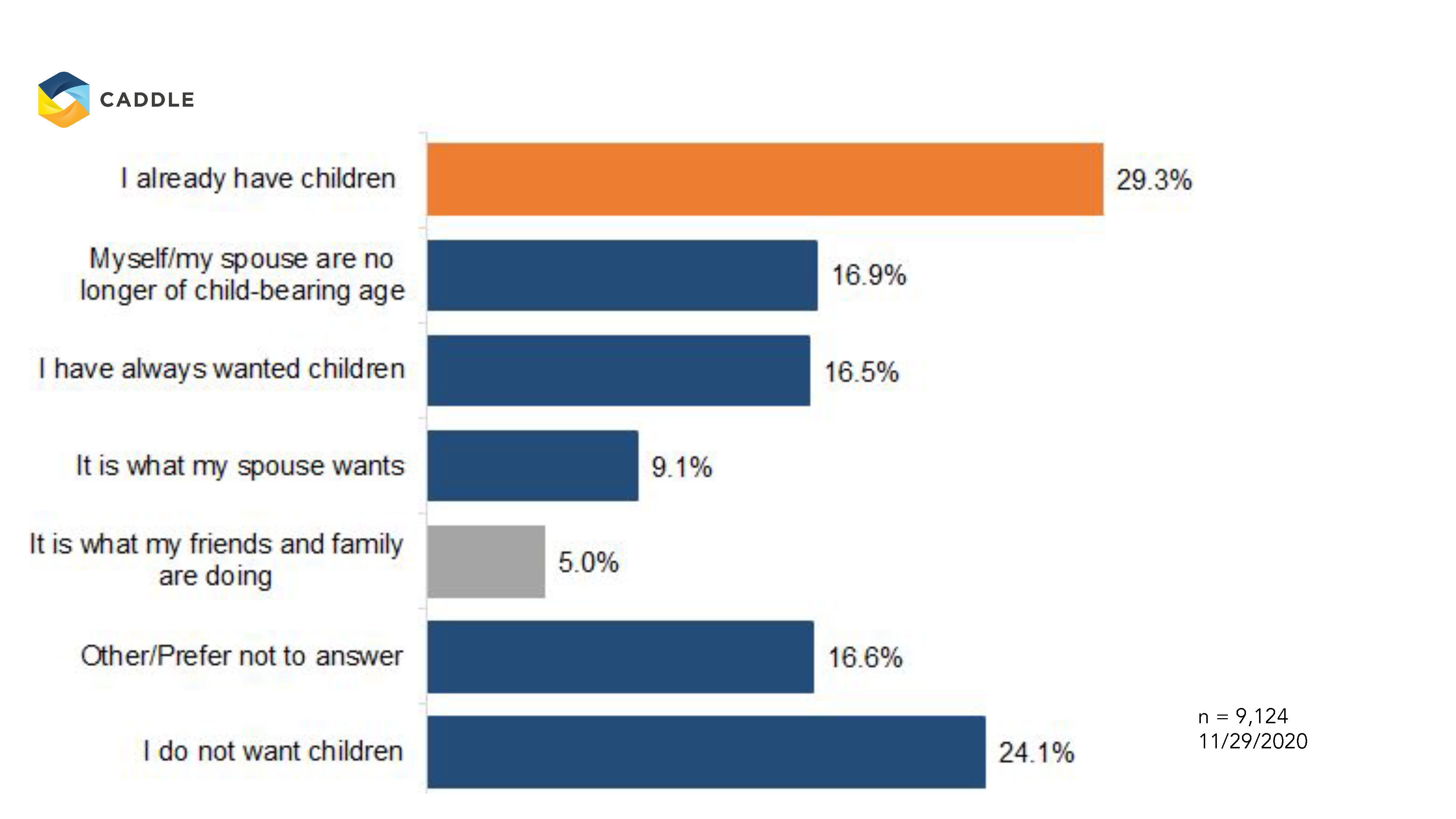
Does the factor of whether they’re already parents make a difference?
Yes, indeed!
Respondents who are currently parents over-index significantly in already having children, and at the same time, weigh their and/or their spouses’ ability to have children more highly than the general population. In contrast, non-parents differed significantly, with more than a third indicating they don’t want children and another 26% suggesting they always wanted children.
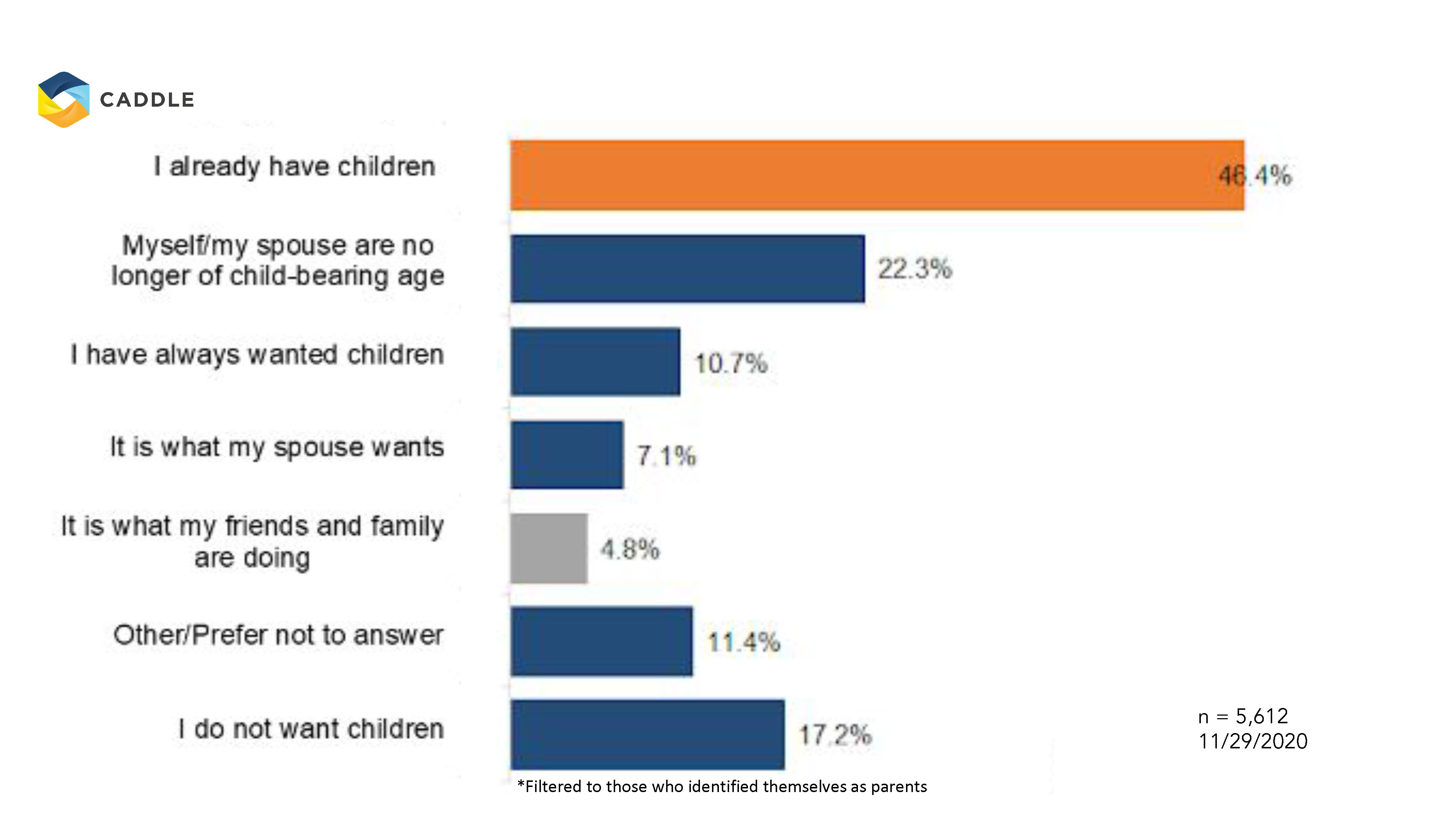
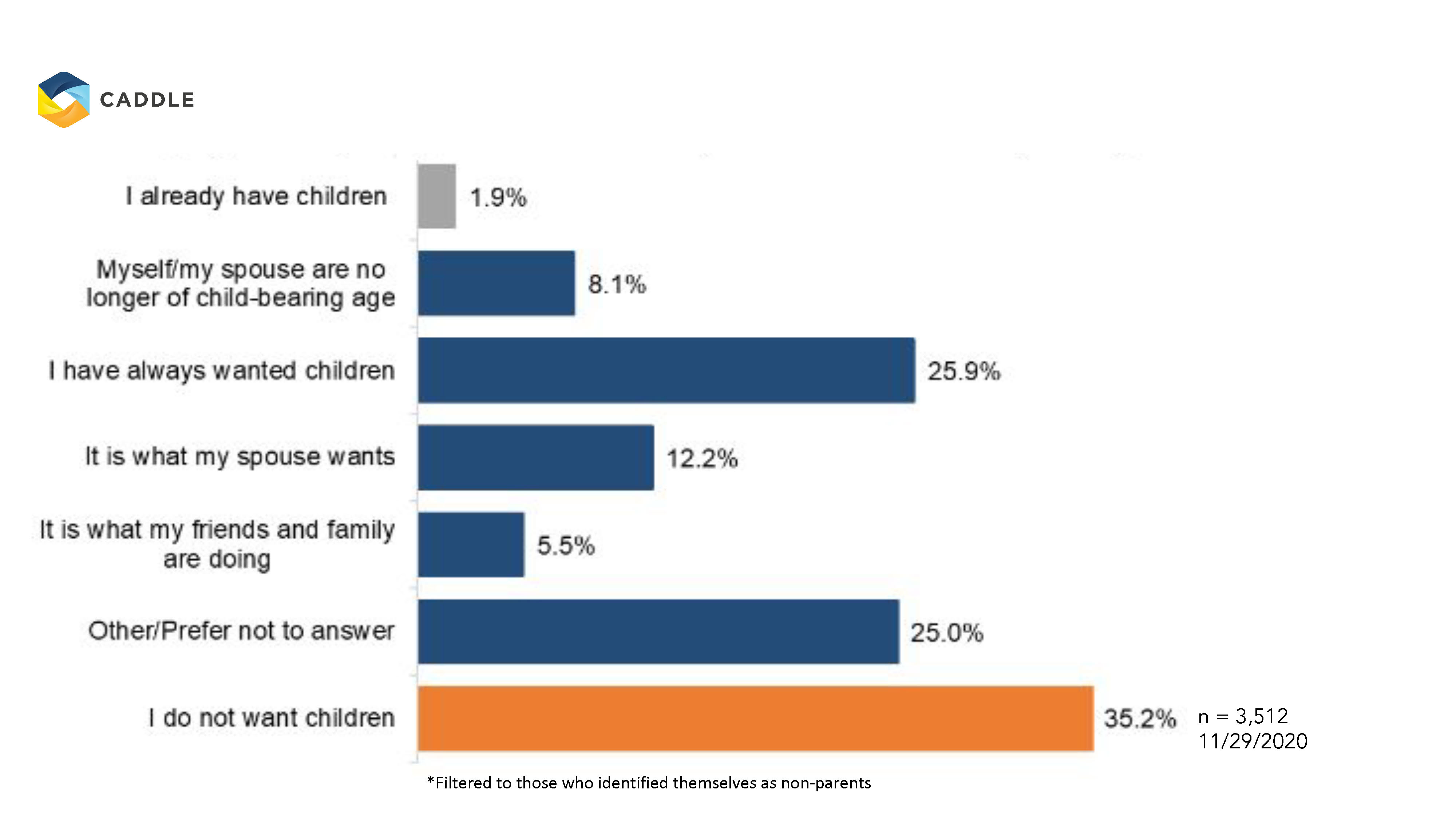
Important side note: Millennials make up 58% of the non-parent segment in this sample, which goes a long way to explaining the relatively small proportion of responses that indicate age as an influence on child-bearing. In contrast, Gen Xers and Millennials are more evenly represented in the “current parents” segment (at 41% and 37% respectively), which edges them somewhat closer to the point in life where bearing children becomes a more complicated prospect, though not completely out of the question.
KEY TAKEAWAYS
Canadians are still planning on having babies—especially younger folks
Caddle Daily Panel survey results suggest that a decent proportion of the Canadian population are still intent on bearing and rearing children. And while Baby Boomers are getting too old to have kids (they now account for the majority of seniors in Canada) and Gen Xers feel that they’ve had enough kids already, Millennials want children and aren’t letting the pandemic stand in their way. Meanwhile, Gen Zers have always wanted kids and still do.
This poses an opportunity for forward-looking retailers to think about the varying demographics of parents, and further tailor their baby assortment to the tastes of different parental age groups. For instance, we know that younger generations tend to be more tech savvy and sustainability conscious. So, consider bringing more innovation and technology to traditional baby categories with game-changing products like smart diapers that notify parents when they need changing or pacifiers made from sustainably sourced latex rubber.
COVID-19 will continue to give would-be parents pause for thought
The pandemic has and continues to play mind games with many Canadians: On the one hand, we know that COVID has had a negative effect on Canadians’ mental health, and the potential for postpartum depression could only make this worse. Yet, we also know that many Canadians (and especially younger segments) are looking for any silver lining they can find from 2020—and what better silver lining is there than welcoming a new baby into the family in the New Year?
As such, retailers should expect steady business from baby- and child-care categories through 2021 and beyond, though some non-essential purchases may come in fits and starts as COVID-driven concerns dovetail with pregnancy side effects for new parents.
Financial and health concerns are unlikely to go away anytime soon
Our Daily Panel surveys have uncovered a consistent pattern of financial and health concerns among the majority of Canadians. Such concerns are obviously weighing heavily on people’s minds and though it hasn’t completely deterred people from starting or expanding their families, it’s definitely made them question their priorities.
Forward-thinking retailers will want to keep such concerns in mind and consider ways to make child-rearing a less financially taxing endeavour. Some ideas: Extend rewards programs to cover the many costs associated with newborns, perhaps considering cash-back as an option to cover childcare. Or, deploy lifecycle marketing campaigns that track and reward parents for their children’s milestones.
*Disclaimer: all data presented is owned by CaddleⓇ and has a Margin of Error of 1% or lower.
Want more Caddle Insights?
Sign up to our email list!
COVID-19 Did Not Steal Canadians' Holiday Spirit
Canadians plan for holiday celebrations at home
Published on December 10,2020
This holiday season: how are Canadians celebrating?
Canadians are planning to keep up holiday spirits by cooking & baking at home this year.
Caddle found out that everyone is reducing gatherings over the holiday season.
What are Canadians planning to do more/less of this holiday season?
Let’s find out.
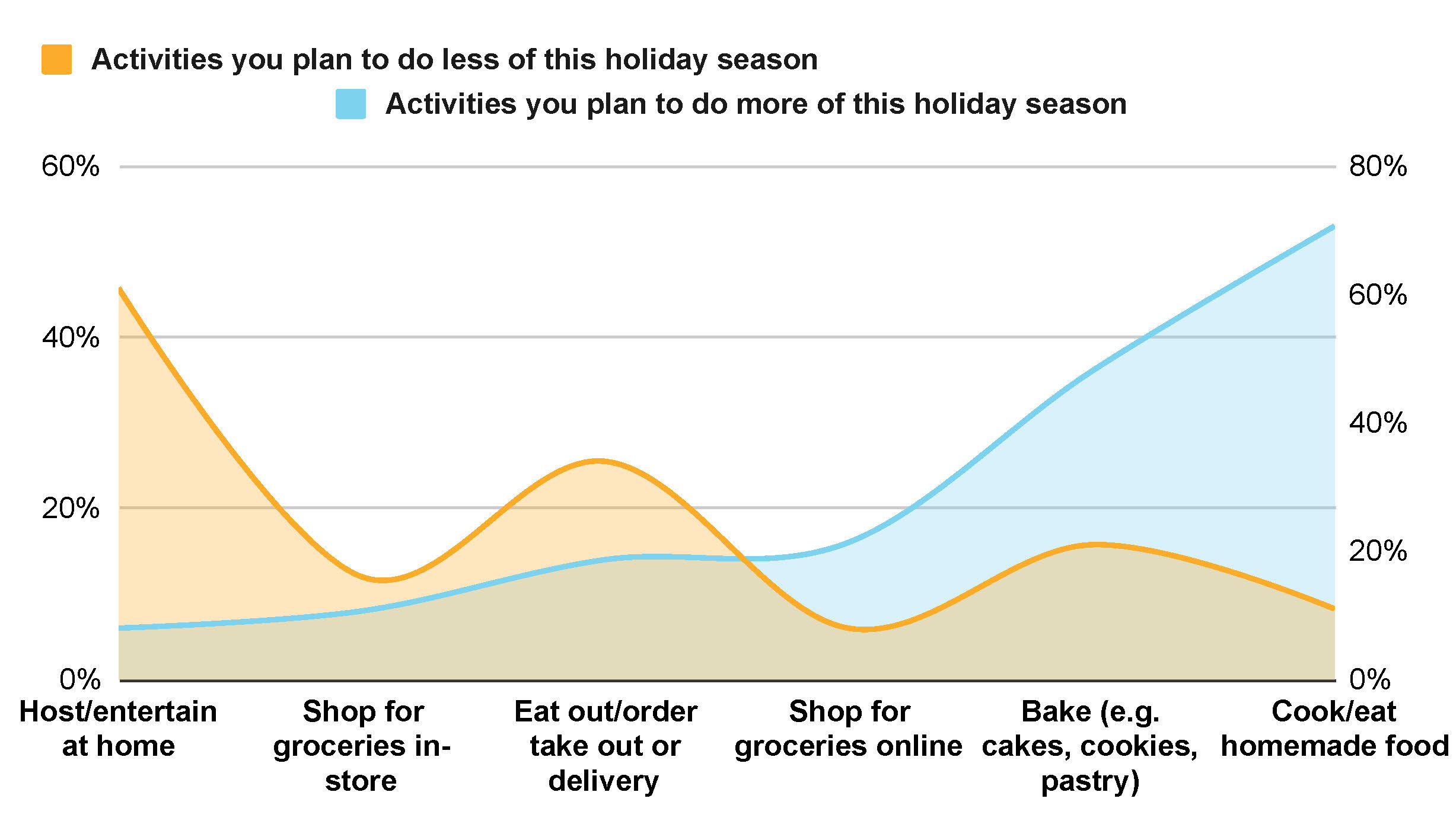
Canadians plan to…
entertain less,
host less gatherings, &
shop for groceries less in-store due to the pandemic.
Instead, consumers are
cooking more,
baking more, &
shopping for groceries online.
In fact,
Over 87% of Canadians plan to cook or bake at home this year.
Tis' the Season of Baking: 67% of Canadians
are planning on doing some form of baking over the holidays.
Q: Are you, or someone in your household, planning to bake during the holidays?
Sign up for Caddle Insights
But how are Canadians feeling about the holiday season? Anxious? Excited? Nervous?
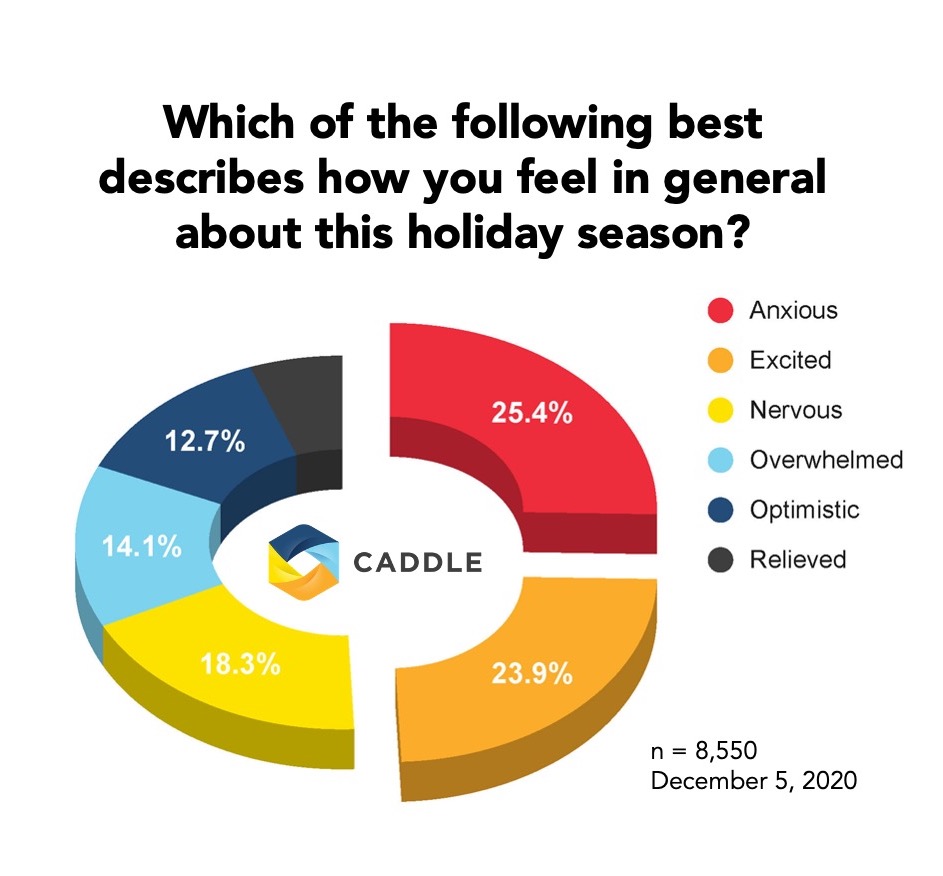
Finally,
Holiday cheer is strongest among the youngsters as
Gen Z are 15% more excited for the holidays compared to Baby Boomers,
with 24% vs. 9% respectively.
*Disclaimer: all data presented is owned by CaddleⓇ and has a Margin of Error of 1% or lower.
Want more Caddle insights? Sign up to our mailing list below!
Sustainability: Canadians are All Talk with a Slow Walk
90% of Canadians say they care about sustainability, but COVID-19 has affected whether we act on these values.
Published on December 2, 2020
At its broadest, sustainability is “development which meets the needs of the present without compromising the ability of future generations to meet their own needs”.
Canadians have by and large been held up as sustainability conscious consumers.
Back in 2017, a report from the Business Development Bank of Canada showed that more Canadians were integrating environmentally responsible practices into their lifestyles—
and they expected companies to do the same.
Whether it’s recyclability, biodegradability, less waste going into landfills… Caddle wanted to test the assumptions that Canadians are environmentally driven. We were also curious as to whether Canadians would keep to their values in the face of pandemic restrictions that make it harder to lead an environmentally conscious lifestyle.
Did you know?
Caddle® is the largest daily and monthly active panel in the Canadian market.
Receive Our Free Weekly Insights Newsletter!And so,
Caddle dug into consumer sentiments and behaviour on sustainable practices and products. Let’s start with
whether Canadians really do consider sustainability in their daily lives.
Sustainability is important to the vast majority of Canadians.
Do Canadians Actually Care?
Back in May 2020, the answer was a resounding ‘yes’—across all demographic groups and regions.
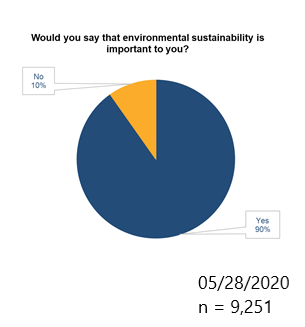
Does Consumer Sentiment on Sustainability Actually Influence Behaviour?
While many Canadians raise clear concerns about sustainability practices, their actions don’t always match —especially during COVID-19. Let’s look at how sustainability figures in Canadian consumers’ daily lives.
Use of Plastics
While 60% of consumers were concerned about the increased use of plastic during COVID-19 (especially Gen Zers and Millennials),
50% of respondents are using the same amount of plastic compared to pre-pandemic,
and almost
1 in 4 consumers are using more!
(Gen Zers and Millennials over-index at 26.5% and 25.7% respectively).
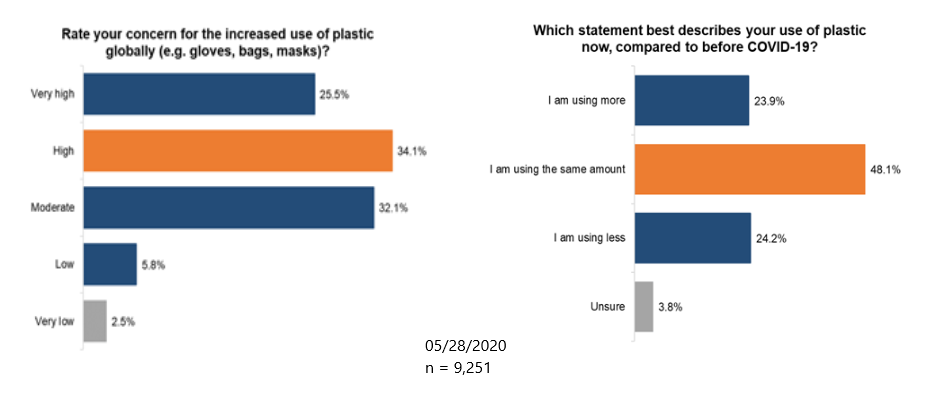
Curiously,
consumers in British Columbia—the stereotypically eco-conscious—seem to be the least aligned with sustainability efforts. Though B.C. consumers expressed the greatest concern with the global increase in plastic use, they also reported the
highest % of single-use plastic usage since the pandemic began!
In contrast, Maritimers—who draw tourism dollars for its scenic landscapes like the West Coast—walk the sustainability talk a bit more, over-indexing on lower plastic use in general.
Use of Plastics in Shopping
Most consumers are either “frustrated” or “indifferent”
about not being able to make use of reusable shopping bags in-store.
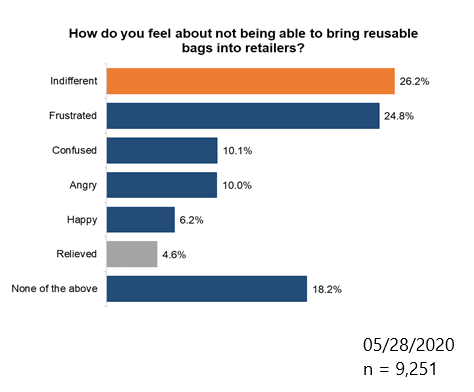
Who’s Most Frustrated of All?
Millennials (26%), though they’re also among the most indifferent consumers, tied with Gen Zers (at 28.2% and 28.5% respectively) and outflanking older generations for “indifference” by at least 3 points.
Meanwhile,
more than 50% of all consumers "strongly agree”
they’ll go back to shopping with reusable bags after the pandemic.
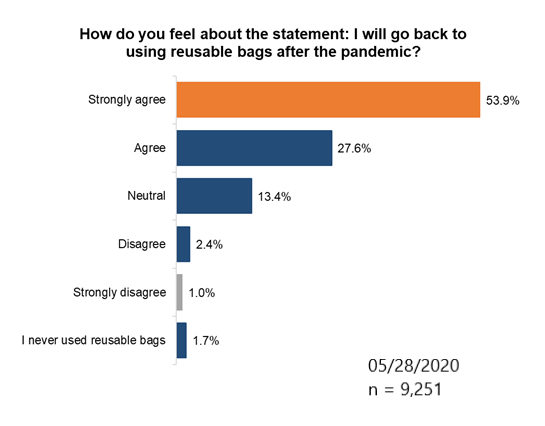
Who is least likely to go back to reusable bag use?
Gen Z! If you guessed the youngest generation, you’re right.
Sustainable Packaging
About 1 in 4 of all consumers find environmental sustainability “very important” when purchasing a product; this holds true across all demographic and geographic groups.
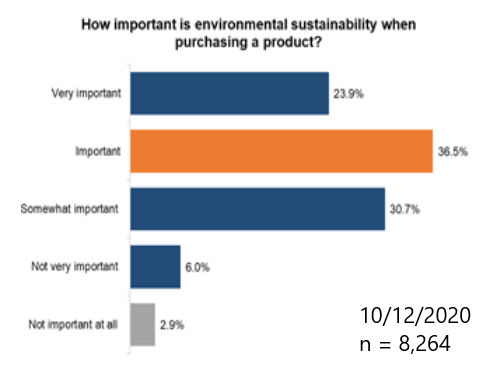
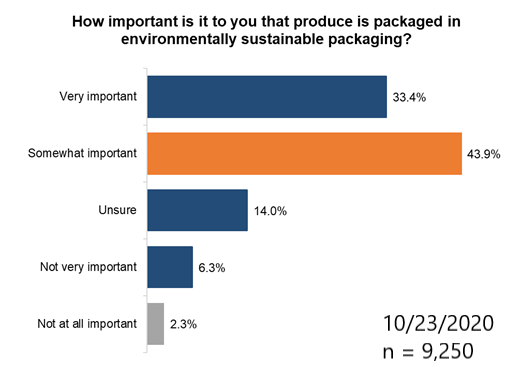
Consumers are especially interested in environmentally sustainable packaging for produce purchases. 80% of consumers suggest it’s “somewhat important”/“very important.”
In fact,
more than 40% of consumers are willing to pay up to 5% more for produce that is packaged sustainably,
though more so among older generations. Consistent with earlier findings, this suggests older consumers either have more dollars to spend on sustainable products OR have greater intent to do so.
Reusable packaging is the strongest influence in purchasing a new product—
though the younger the consumer, the less they seemed to value reusable packaging.
Is this further indication that Canada’s youngest generations place more emphasis on other elements of sustainable consumption?

Finally, 40%
of Canadian consumers are likely to switch brands
if their preferred company didn’t make environmentally sustainable packaging. Note* packaging is a relevant concern for eco-conscious consumers.

KEY TAKEAWAYS
1. Canadian Consumers Care About the Type of Packaging that Manufacturers Use.
Canadian consumers don’t just think sustainable packaging is more important; many consumers (particularly older generations) would pay more
for sustainably packaged products and they’d ditch their preferred brands if they aren’t offered in environmentally sustainable materials.
The opportunity is ripe for retailers to increase share of wallet
by expanding their assortment of products that are packaged using sustainable and/or reusable materials.
And for retailers with white-label assortment: adapting packaging now to more sustainable options isn’t just a good environmental choice;
it may help you to better compete with global brands, too.
2. Younger Consumers Think About Sustainability Differently.
We’ve heard talk for years (and have copious evidence to back it up!) about how
Gen Zers and Millennials are leading the charge on environmental issues. Yet,
our results indicate that many of the measures we typically associate with “capital-S Sustainability” just don’t seem to mean as much to Canada’s younger consumers.
The fact of the matter is,
if you’re truly going to understand the thinking and behaviour of any demographic—whether Gen Z or the Greatest Generation or anyone in between
—you need plenty of good, reliable data.
And so, it’s incumbent on retailers and manufacturers to continue to work with partners like Caddle to gather as much broad-spectrum data as possible, if they’re going to really
get into the heads, hearts and wallets of these up-and-coming change-makers.
3. COVID-19 is Affecting Canadians in Surprising Ways
Perhaps it’s just the malaise we’re all feeling from the seemingly never-ending restrictions and changes to life as we know it. And you’d think with lockdowns and restricted comings-and-goings, people would be using less plastic—especially if they eschewed single-use plastics pre-pandemic.
But,
up to 25% of Canadian respondents report using more single-use plastics now than before the pandemic struck.
This signals to us that
the pandemic will continue to throw some surprising curveballs at retailers and product manufacturers
in the coming months. To manage, retailers should maintain a holistic assortment of products and services. That way, regardless of inconsistencies that may occur between sentiment and behaviour, they’re still catering to as wide a population as possible at any given time.
Looking to know more about consumers and their views, intentions and habits towards plastics and sustainability? Contact us today.
*Disclaimer: all data presented is owned by CaddleⓇ and has a Margin of Error of 1% or lower.
Contact Us
Gen Z Joins Shopping Mall-Walking Trend as Exercise This Winter!
Published on November 20, 2020
With pandemic closures expected to continue into the holiday season and possible COVID-19 spikes, are shopping malls the fitness solution we’re all in need of?
So, are consumers using shopping malls for mall-walking to stay fit?
We asked over 8500 Canadians
last week and almost half of all respondents are worried about sticking to their fitness routines this winter. For Canadians who visit malls,
47% are interested in visiting a shopping mall for exercise during the winter. Surprisingly, Gen Z are the most interested
in visiting a shopping mall to exercise during the winter.
Are Gen Z the new generation of “mall-walkers”?
Are walk/run lanes at shopping malls a hot thing this winter?
Gen Z are Twice as Worried About Exercise
n = 8,577 | November 15, 2020
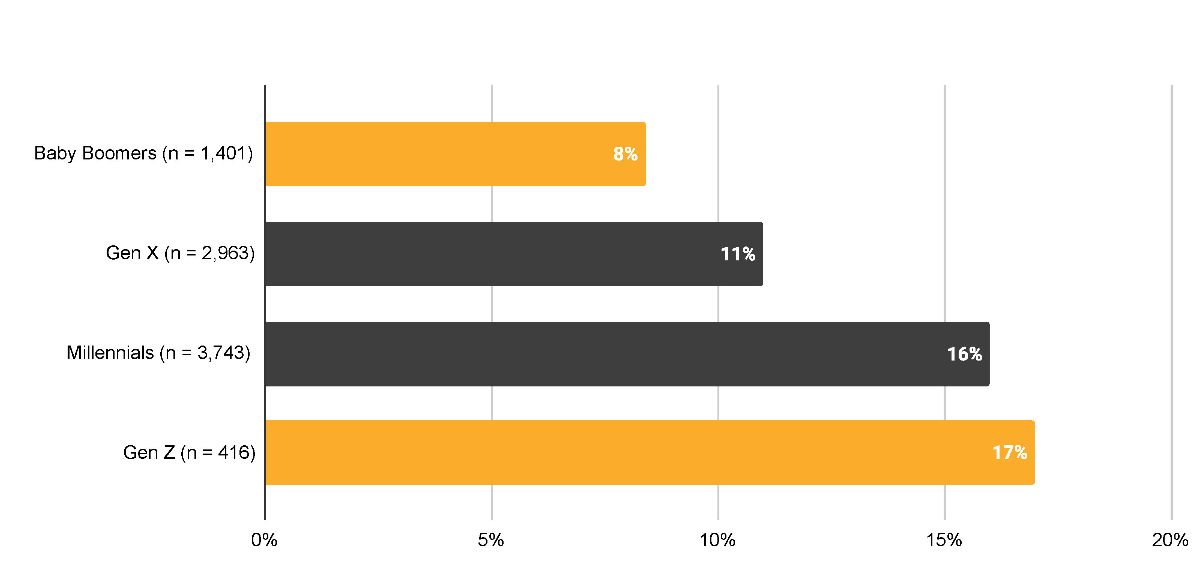
Gen Z over-index more than 2X when compared to Baby Boomers and say they are
“extremely worried”.
As a result,
many are looking to shopping malls as their physical activity of choice in order to get their daily steps in.
Again, of the consumers that visit malls often or sometimes,
Gen Z are 2X as interested in a run/walk lane at their local shopping mall when compared to Baby Boomers!
Caddle is the largest mobile provider of Canadians insights with 10,000+ daily active panel members. Our data is used by research firms including Nielsen, Environics, & major CPG/retailers like P&G, Coca Cola, Nestle, Walmart, Canopy and many more.
Sign-Up for Caddle’s Weekly Insights Report and never miss a beat on the newest Canadian consumer insights!
